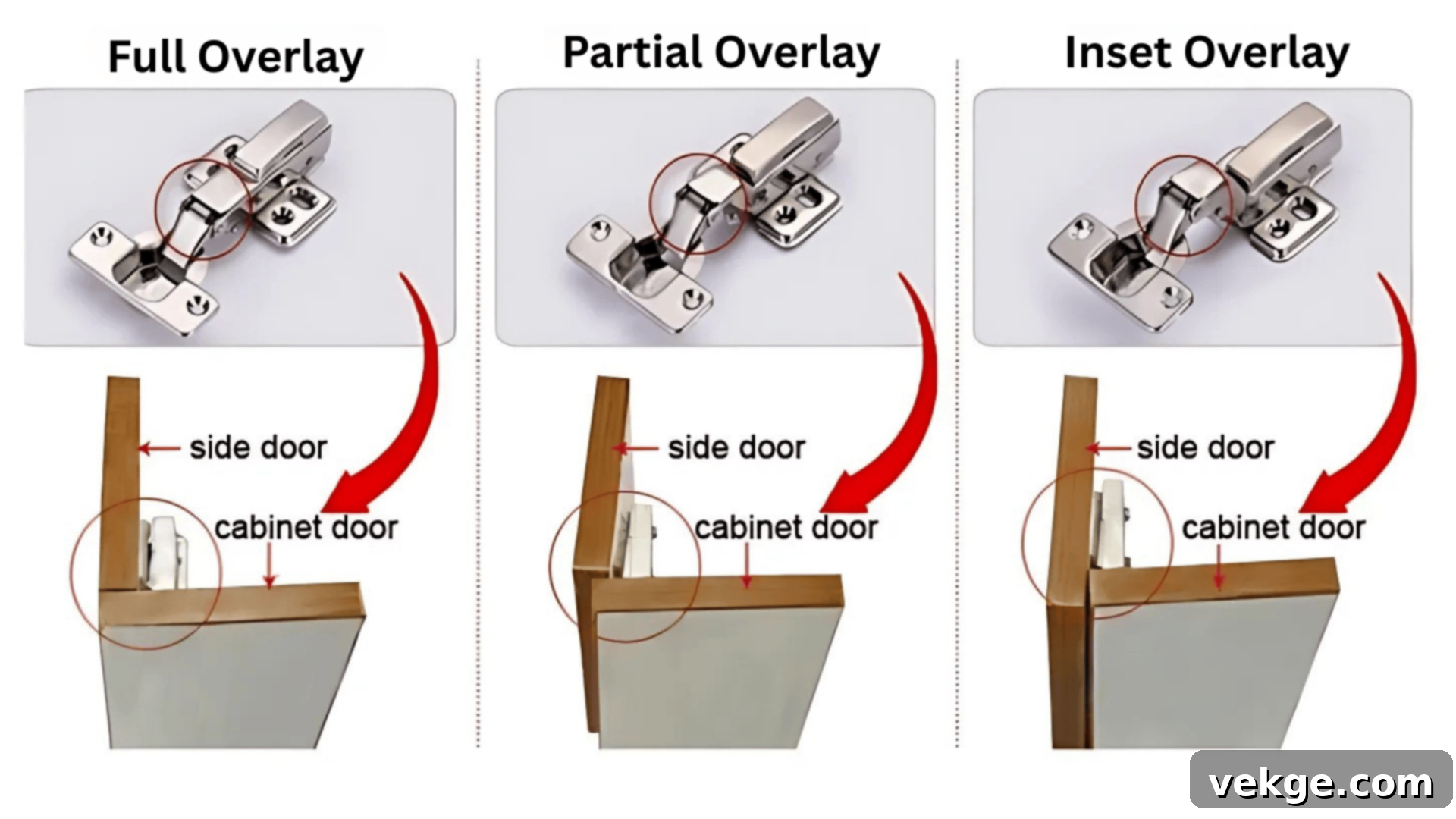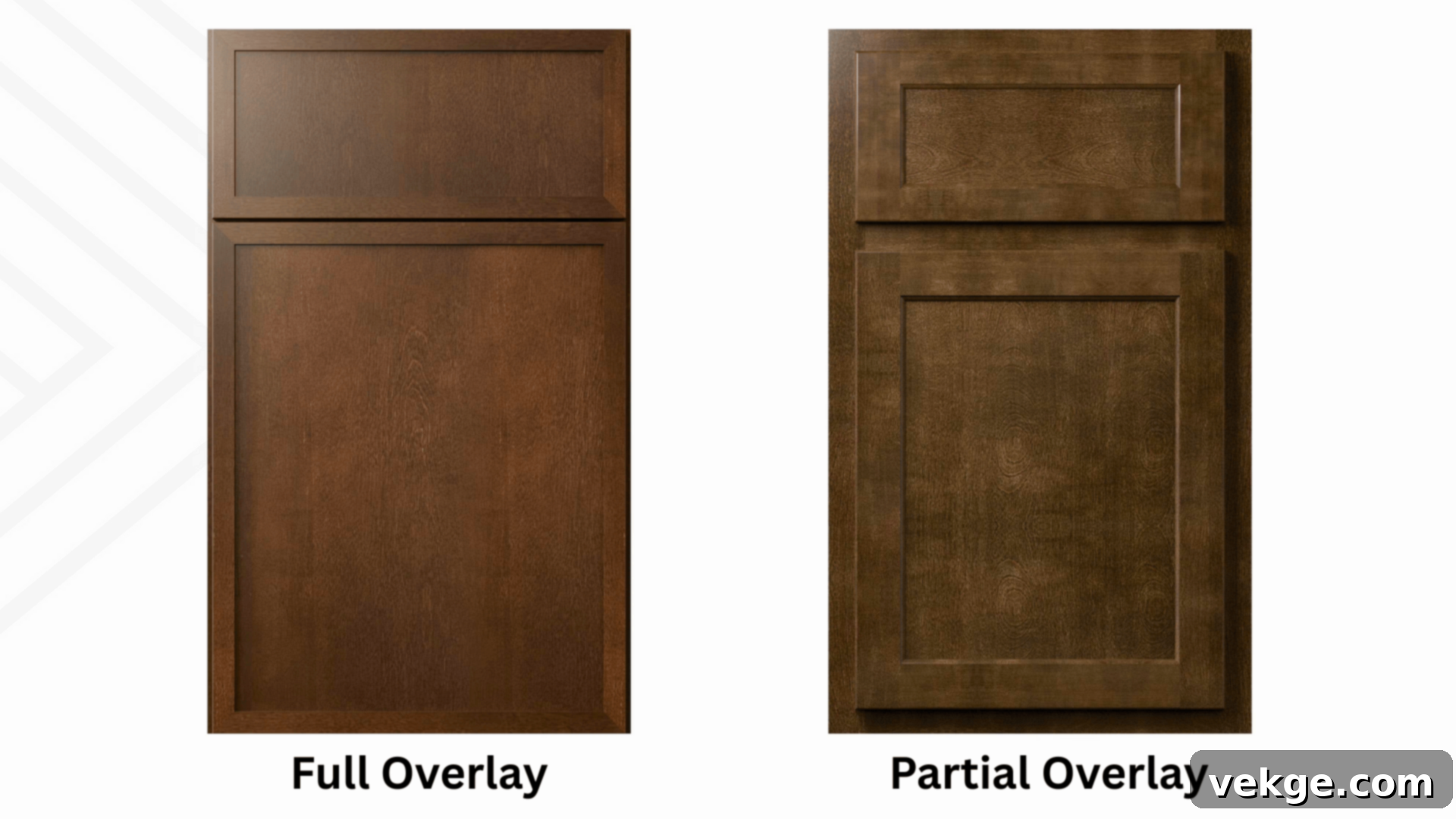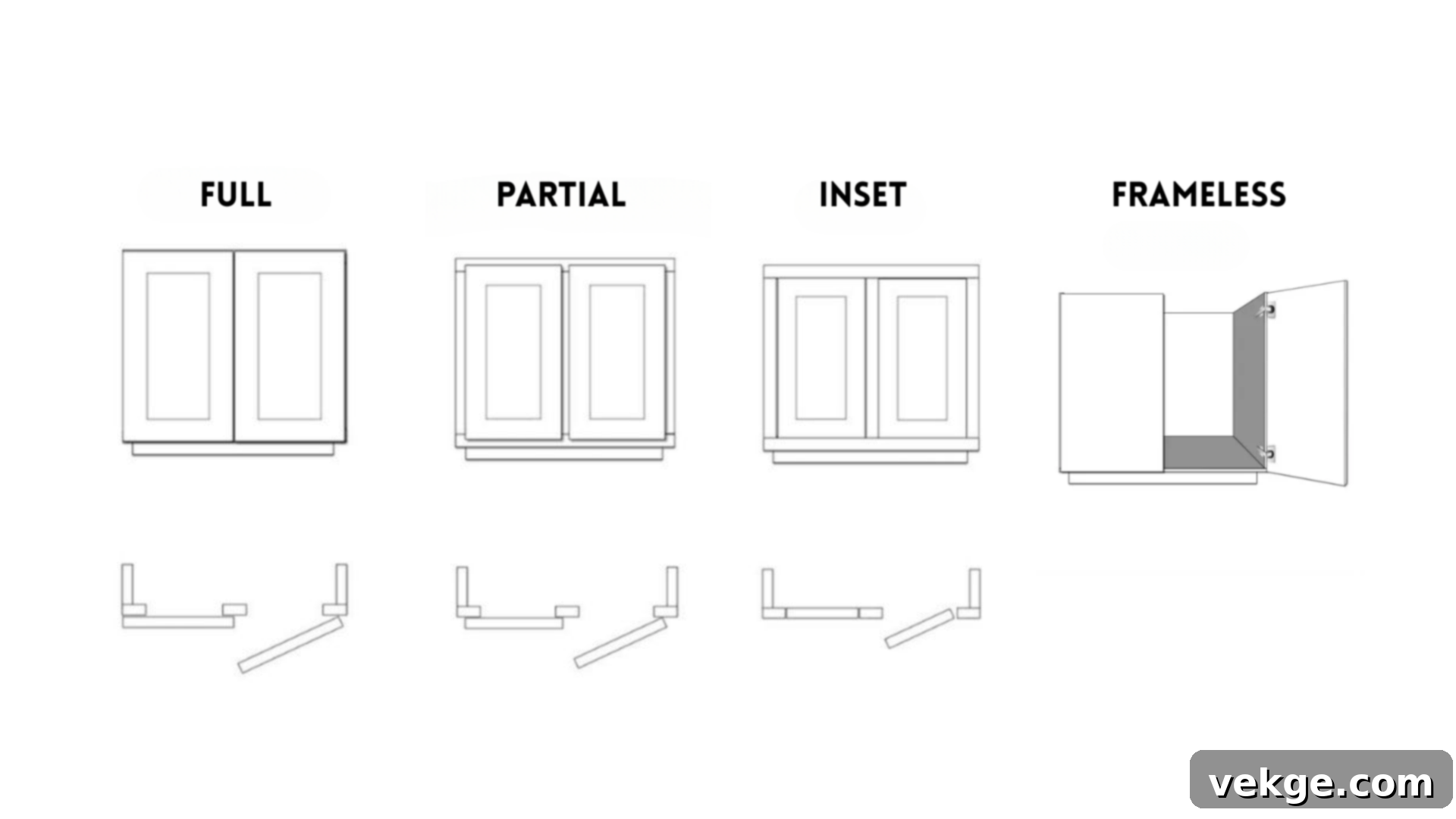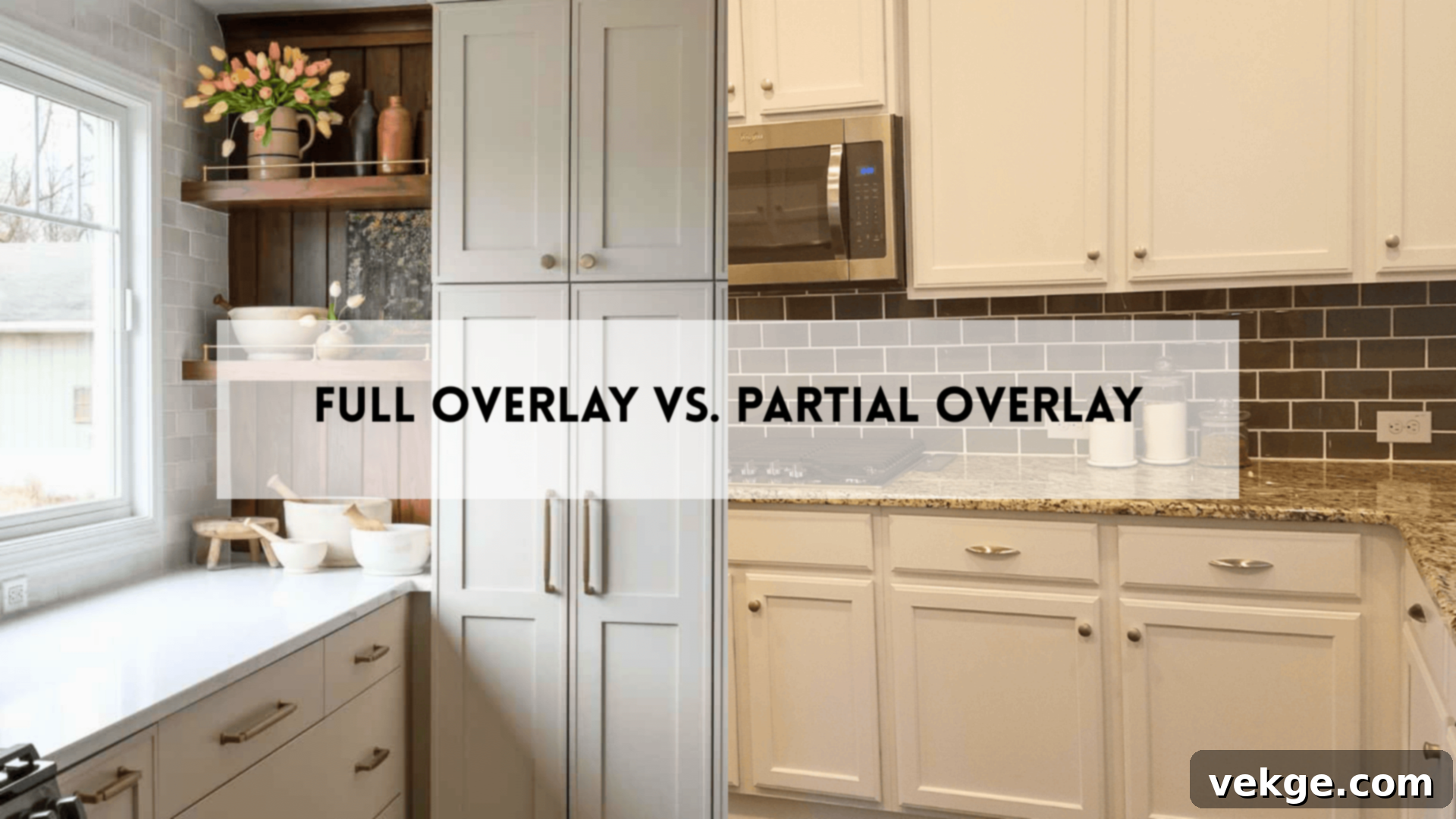Full Overlay vs. Partial Overlay Cabinets: The Ultimate Guide to Choosing Your Style
Embarking on a kitchen or bathroom remodel often brings a whirlwind of design decisions, and one of the most crucial yet often overlooked choices is your cabinet style. Many homeowners find themselves puzzled by terms like “full overlay” and “partial overlay,” unsure of the aesthetic and functional implications of each. Choosing the wrong cabinet overlay can significantly impact your overall design, budget, and even the daily usability of your space.
This comprehensive guide is designed to demystify cabinet overlays. We’ll explore what each term means, delve into their distinct appearances, weigh their pros and cons, and help you determine which option aligns perfectly with your space, budget, and design aspirations. By the end of this article, you’ll be equipped with the knowledge to confidently select the right cabinet style, whether you’re undertaking a DIY upgrade or collaborating with a professional contractor. Understanding these differences can save you valuable time, money, and potential design headaches down the line.
What is a Cabinet Overlay?

At its core, a cabinet overlay refers to the extent to which a cabinet door or drawer front covers the face frame of the cabinet box. This seemingly small detail plays a pivotal role in the overall aesthetic and functionality of your cabinetry. Broadly, cabinet styles are categorized into two main groups: overlay and inset. In overlay cabinets, the doors sit on top of the cabinet frame, while in inset cabinets, the doors fit precisely inside the frame, creating a flush, built-in appearance.
Within the overlay category, there are two primary variations: full overlay and partial overlay. The distinction lies in how much of the cabinet’s face frame remains visible. Full overlay doors are designed to cover nearly the entire face frame, leaving only minimal gaps between doors and drawers. In contrast, partial overlay doors expose a significant portion of the face frame, creating a more traditional look with visible borders around each cabinet opening.
To fully grasp the concept of overlays, it’s helpful to understand basic cabinet construction. Most cabinets consist of three main components: the cabinet box (the structural core), the face frame (the front-facing wooden structure that supports the doors and drawers), and the doors/drawer fronts themselves. The face frame not only provides structural integrity but also defines where the doors will attach. The chosen overlay style dictates how these doors align with and cover this frame, influencing everything from visual continuity to the perceived amount of storage space. It’s a fundamental design element that dictates the character and flow of your kitchen or bathroom cabinetry.
Full Overlay Cabinets: A Sleek, Modern Choice
Full-overlay cabinets are a top choice for those seeking a contemporary and streamlined aesthetic in their kitchens and bathrooms. By maximizing the coverage of the cabinet frame, this style delivers a clean, seamless look that is highly desirable in modern design schemes.
The defining characteristic of a full overlay is that the cabinet doors and drawer fronts extend almost entirely over the cabinet’s face frame. This design minimizes the visible gaps between adjacent doors and drawers, typically leaving only a small, consistent reveal (often around 1/8 inch or less). The result is a smooth, uniform appearance that gives the impression of a continuous block of cabinetry, often enhancing the perception of space and luxury.
Appearance and Design
Full overlay cabinets are synonymous with modern elegance. Their minimal visible lines create a sleek, uncluttered aesthetic that perfectly complements contemporary, minimalist, and even transitional kitchen designs. This style often gives cabinets a furniture-like quality, making them appear custom-built and sophisticated. Furthermore, full overlay is the standard for frameless cabinet construction (also known as European-style cabinetry), where the absence of a face frame inherently leads to doors covering the entire box opening, reinforcing the clean, linear look.
Full Overlay Cabinets: Pros and Cons
Understanding the advantages and disadvantages will help you determine if full overlay is the right fit for your home.
Pros:
- Smooth, High-End Appearance: The minimal gaps between doors and drawers create a sophisticated, custom-built look that is highly sought after in modern interiors. This visual continuity can elevate the entire room’s design.
- More Accessible Storage Space: Because the doors cover the entire face frame, the opening for the cabinet box is larger compared to partial overlay. This provides slightly more interior access, making it easier to store and retrieve larger items, and maximizing usable storage volume.
- Easy to Match with Modern Styles: This style naturally integrates with contemporary, minimalist, and industrial designs. Its clean lines and continuous surfaces create a cohesive and unobtrusive backdrop for other design elements.
- Popular in New Builds: Due to current design trends, full overlay is often the default choice in new home constructions, which can be a plus for resale value.
Cons:
- Higher Cost: Full overlay cabinets generally cost more than partial overlay. This is due to the increased precision required in manufacturing and installation, as well as the need for specialized concealed (Euro-style) hinges.
- Requires Precise Installation: The minimal gaps demand extremely accurate measurements and meticulous installation. Even slight misalignments can be visibly obvious, leading to a less polished look. This often translates to higher labor costs if hiring professionals.
- Less Room for Error with Hinges and Hardware: The specialized hinges needed for full overlay cabinets require careful adjustment to ensure proper door alignment and smooth operation. Any imperfections in hardware installation or door sizing can be quite noticeable.
- Potential for Door/Drawer Collisions: With minimal space between fronts, there’s a higher chance of adjacent doors or drawers bumping into each other if not opened carefully, potentially causing wear or damage over time.
Partial Overlay Cabinets: A Timeless and Practical Choice
Partial overlay cabinets represent a more traditional and widely recognized option, characterized by their visible cabinet frames. While they have been a staple in homes for decades, they continue to be a popular and practical choice today, especially for those favoring classic aesthetics or working within specific budgets.
With a partial overlay, cabinet doors and drawer fronts only cover a portion of the face frame, leaving a distinct margin of the frame exposed around the edges of each door and between adjacent doors. This visible gap is typically about 1/2 inch to 1 inch, creating a framed appearance for each individual cabinet opening. This style offers a different visual language compared to the sleek continuity of full overlay designs.
Appearance and Design
Partial overlay cabinets naturally lend themselves to a more classic, casual, or rustic aesthetic. You’ll frequently encounter them in traditional, farmhouse, country, or budget-friendly kitchen designs. The visible frame around each door and drawer front adds definition and a sense of individual character to each cabinet unit. Some homeowners appreciate this visual segmentation, as it can highlight the craftsmanship of the cabinet construction and evoke a sense of heritage. This style provides a comforting and familiar look that has endured through various design trends.
Partial Overlay Cabinets: Pros and Cons
Here’s a breakdown of the advantages and disadvantages of choosing partial overlay cabinets for your home.
Pros:
- More Affordable: Generally, partial overlay cabinets are less expensive to manufacture and purchase than full overlay options. This is largely due to less stringent precision requirements during production and installation, as well as the use of more common, often less expensive, exposed hinges.
- Easier to Install: The larger gaps between doors and the exposed frame provide more tolerance for minor imperfections during installation. This makes them more forgiving and often quicker to install, potentially reducing labor costs for DIYers or contractors.
- Good for Traditional and Rustic Styles: The visible frame perfectly complements classic, farmhouse, rustic, and country-style kitchen designs, adding a traditional charm and defining individual cabinet units.
- Less Prone to Damage: The larger gaps mean doors and drawers are less likely to collide, reducing the risk of nicks or wear over time.
Cons:
- Exposed Cabinet Frame: While a pro for some, the visible frame can be a con for those desiring a seamless, modern look. The exposed frame can also accumulate dust and grime, requiring more frequent cleaning.
- Less Seamless Appearance: The gaps between doors and drawers create visual breaks, which can make the overall cabinetry appear less streamlined and potentially break up a continuous design.
- Slightly Less Storage Access: The visible face frame slightly reduces the effective opening size of the cabinet box. While the interior space remains the same, the access point is marginally smaller, which can be a minor inconvenience for very wide items.
- Can Appear Dated to Some: In an era dominated by sleek, modern designs, partial overlays can sometimes be perceived as outdated by those who prefer contemporary aesthetics.
If you’re operating within a stricter budget, prefer a more classic cabinet style, or are renovating an older home where a traditional aesthetic would fit best, partial overlay cabinets remain a solid and attractive choice.
Full vs. Partial Overlay: Key Differences

Choosing between full and partial overlay cabinets is a fundamental decision that will shape the look and feel of your kitchen or bathroom. This choice hinges on several factors, including your aesthetic preferences, practical needs, and, significantly, your budget. Each type boasts distinct strengths and characteristics. Understanding these key differences can empower you to make a more informed and satisfying decision for your home renovation project.
Here’s a clear comparison to help break down the core distinctions:
| Feature | Full Overlay | Partial Overlay |
|---|---|---|
| Cost | Usually more expensive due to higher manufacturing precision and specialized hardware. | More budget-friendly, reflecting simpler construction and common hardware. |
| Look | Sleek, modern, and seamless with minimal gaps between doors and drawers, giving a continuous surface. | Traditional, classic, or casual with a visible cabinet face frame around and between doors, defining individual units. |
| Storage Space | Maximizes access to the interior cabinet opening, as doors cover the entire face frame, allowing for easier storage and retrieval of items. | Slightly less accessible opening due to the visible frame partially obstructing the entry point, though interior volume is similar. |
| Installation | Requires precise alignment and spacing due to minimal reveals, demanding skilled labor and careful adjustments for a flawless finish. | More forgiving and easier to install due to larger tolerances and visible gaps, making it suitable for DIYers or less specialized labor. |
| Hardware | Typically uses concealed (Euro-style) hinges for a hidden, modern look and smooth operation. | Often uses exposed hinges, or occasionally concealed hinges, which are simpler to install and adjust. |
| Design Compatibility | Ideal for contemporary, minimalist, transitional, and European-style designs. | Best suited for traditional, farmhouse, country, and rustic aesthetics. |
When to Choose Full Overlay or Partial Overlay
The optimal choice between full and partial overlay cabinets is deeply personal and depends on a careful assessment of your budget constraints, overarching design goals, and the practical considerations of your space. Here’s a more detailed guide to help you pinpoint the best fit for your project:
Budget-Based Decision
- Go with partial overlay if you’re working with a tighter budget. The manufacturing and installation costs are generally lower, making it a more economical choice without sacrificing quality or functionality. It allows you to allocate funds to other renovation aspects.
- Choose full overlay if you desire a more custom, high-end finish and your budget allows for a slightly greater investment. The increased precision and sophisticated appearance justify the higher cost for many homeowners seeking a premium look.
Style Match: Modern vs. Traditional
- Full overlay works best with modern, minimalist, or contemporary styles. Its smooth, seamless look creates an uncluttered environment, perfect for sleek appliances and clean lines. If you’re aiming for a magazine-worthy, cutting-edge kitchen, full overlay is your ideal match.
- Partial overlay fits better with traditional, rustic, or farmhouse designs. The visible framing adds a classic charm and definition, enhancing the warmth and character typical of these styles. If you appreciate a homey, inviting, and time-honored aesthetic, partial overlay will complement your vision beautifully.
Space and Layout Considerations
- Full overlay cabinets offer maximized access to the interior, which is incredibly helpful in smaller kitchens or tight spaces where every inch of functional storage counts. The wider door opening makes it easier to place and retrieve items, enhancing overall usability.
- A partial overlay might be perfectly suitable for larger kitchens where maximizing every fraction of storage space isn’t as critical. The slightly reduced access might be negligible in a spacious layout, and the aesthetic benefits might outweigh this minor functional difference.
Before finalizing your pick, take a moment to prioritize what truly matters most for your home: is it cost-effectiveness, a specific aesthetic appeal, or optimal space utilization? Your answer will confidently guide you to the right cabinet overlay choice.
Comparing Overlay Cabinets with Inset and Frameless Styles

While full and partial overlays are popular choices, it’s also important to understand where they fit within the broader spectrum of cabinet construction. Once you’ve explored overlay options, you might encounter other distinct styles like inset or frameless cabinets. Each offers unique advantages and visual characteristics, and understanding their differences can help you make a truly informed decision for your project.
Here’s how overlay cabinets compare to these other prominent styles, and when each might be the most sensible choice for your home.
Why Choose Overlay?
Overlay cabinets, encompassing both full and partial varieties, provide exceptional flexibility and a good balance of cost, style, and functionality. They offer the most versatile range for homeowners, allowing you to control how much of the cabinet’s face frame is visible, thereby dictating the overall design mood—from modern sleekness to classic charm. They are generally easier to install than inset cabinets and offer greater design control without necessarily “breaking the bank.”
Choose overlay if:
- You want a strong balance between style and cost-efficiency, offering a wide range of aesthetic possibilities without the premium price tag of inset.
- You’re replacing existing cabinet doors only, as overlay doors are often simpler to fit onto existing face frames.
- You prefer a quicker, more forgiving installation process, which can be particularly advantageous for DIY enthusiasts or projects with tighter timelines.
- You appreciate a wide selection of hardware options, as both exposed and concealed hinges are readily available for overlay styles.
Why Consider Inset?
Inset cabinets stand out for their premium, furniture-grade appearance. In this style, the cabinet doors and drawer fronts are meticulously crafted to fit precisely inside the cabinet face frame, sitting flush with the frame itself. This creates a beautifully tailored, custom, and often heirloom-quality look reminiscent of fine furniture. The precision required for inset cabinetry is significant, resulting in a distinct, high-end aesthetic.
Choose inset if:
- You’re after a timeless, luxurious, and truly high-end look that exudes classic craftsmanship and bespoke quality.
- You want something truly unique or custom, as inset cabinetry often allows for specialized detailing and finishes that enhance its sophisticated appeal.
- Your project budget allows ample room for precision work and the higher costs associated with the meticulous manufacturing and installation required for a flawless fit.
- You value a perfectly flat and flush front profile, creating a very clean and architectural feel in your space.
When to Go Frameless
Frameless cabinets, also known as European-style cabinets, completely omit the face frame. Instead, the cabinet doors are directly attached to the sides of the cabinet box. This construction method allows for maximum interior storage space, as there is no frame to obstruct the opening, and it provides an incredibly clean, minimalist exterior. You’ll frequently encounter this sleek style in modern European kitchens and contemporary designs.
Choose frameless if:
- You have a small kitchen or bathroom and want to make the absolute most of every cubic inch of interior storage space, as frameless offers slightly wider openings.
- You prefer a modern, streamlined, and highly minimalist design aesthetic where clean lines and uninterrupted surfaces are paramount.
- You’re building new cabinets from scratch, as it provides an opportunity to implement this specific construction style from the ground up.
- You want the widest possible drawers, as the absence of a face frame allows for more usable drawer width.
Installation and Measurement Tips for Cabinet Overlays
Achieving the perfect cabinet overlay, whether full or partial, hinges on accurate measurements and selecting the correct hardware. Precision during these stages will ensure your doors align beautifully, operate smoothly, and maintain their intended aesthetic. Here’s a quick guide to help you navigate the installation process successfully.
How to Measure for Cabinet Overlay
Accurate measurement is the cornerstone of any successful cabinet project. Follow these steps carefully:
1. Measure the cabinet opening: Use a high-quality tape measure to find the exact width and height of the inner opening of the cabinet box. Measure at several points and use the smallest measurement to ensure a snug fit.
2. Measure the current door (if replacing): If you’re replacing existing doors, measure the width and height of one of the current doors. To calculate the existing overlay, subtract the cabinet box opening size from the door size, then divide by two (for the overlay on each side). This tells you how much the current door overlaps the opening on all sides.
3. Decide on your desired full or partial overlay. This will dictate the final door dimensions:
- For a full overlay, your new doors will typically be about 1/2″ to 1″ wider and taller than the cabinet opening, designed to leave only a small gap (usually 1/8″ or 3mm) around the edges and between adjacent doors. This means your door width should be (opening width + 2x desired overlay) and height (opening height + 2x desired overlay).
- For a partial overlay, you’ll allow more of the face frame to show. Common partial overlays are 1/2″ to 1″ on each side. So, a door might extend 1/2″ past the opening on all sides. Your door width would be (opening width + 1″) and height (opening height + 1″) for a 1/2″ overlay on each side.
4. Account for double-door cabinets: If you have two doors closing over a single opening, remember to leave a small space between the two doors (typically about 1/8″) to prevent them from rubbing when opened or closed. This gap must be factored into the overall width calculation for each door.
For a clear visual demonstration on how to measure cabinet overlays effectively, watch the video below. It’s an excellent resource for understanding the practical application of these steps.
Common Hardware Considerations
The type of cabinet overlay directly influences your hardware choices, particularly hinges.
- Hinges: Full overlay cabinets almost always require specific concealed (often called Euro-style or cup) hinges. These hinges mount to the inside of the cabinet box and the back of the door, allowing for smooth, silent operation and a completely clean exterior. Partial overlay cabinets can use either exposed hinges (like butt hinges) or a less complex type of concealed hinge that accommodates the visible frame.
- Clearance: Full overlays demand precision in hinge placement and adjustment to maintain the minimal, consistent gaps. There’s less room for error. Partial overlays are more forgiving, as the wider gaps can hide minor imperfections in hinge alignment or door sizing.
- Knobs and Pulls: Consider the placement of your chosen knobs and pulls carefully. With full overlay, ensure they don’t impede the opening of adjacent doors or drawers due to the tight clearances. For partial overlay, the visible frame provides a natural visual boundary for hardware placement.
Taking the time to measure meticulously and plan your hardware selection proactively will undoubtedly help you avoid common issues later on, particularly concerning door alignment, proper fit, and overall functionality of your beautiful new cabinetry.
Are Partial Overlay Cabinets Outdated?
The question of whether partial overlay cabinets are outdated is common, and the answer is nuanced. For many years, partial overlay cabinets were the standard in traditional kitchen design. They feature doors that cover only a portion of the cabinet frame, intentionally leaving a visible border around each door and drawer front, creating distinct gaps.
Current interior design trends undoubtedly lean toward smoother, cleaner, and more minimalist styles. Consequently, many contemporary designers and homeowners now favor full overlay or inset cabinets for their seamless, uniform, and sleek appearance. The desire for uninterrupted lines and a less busy aesthetic has pushed these styles to the forefront of modern kitchen and bathroom renovations.
In this context, the exposed frame characteristic of partial overlays can, to some, feel dated or less sophisticated. This perception is why they are less frequently specified in new builds or significant remodels that aim for a cutting-edge, contemporary vibe. They don’t typically achieve the “European modern” or “minimalist” look that is currently trending.
However, to label them entirely “outdated” would be an oversimplification. Partial overlay cabinets remain a robust and appealing choice for specific aesthetics and budgets. They are incredibly well-suited for classic, traditional, farmhouse, country, or rustic kitchen designs, where the visible frame contributes to the style’s inherent charm and authenticity. With the right choice of hardware (such as vintage-inspired pulls) and paint colors, partial overlay cabinets can still look incredibly stylish, intentional, and inviting.
Ultimately, “outdated” is often a matter of personal taste and current trends rather than inherent quality or functionality. If a partial overlay aligns with your preferred style and budget, it’s the right choice for your space. Design should reflect your personal aesthetic, not just fleeting trends.
Final Thoughts: Making Your Cabinet Overlay Decision
Deciding between full overlay and partial overlay cabinets is a significant choice that will influence the entire aesthetic and practical experience of your kitchen or bathroom. Each style offers a distinct set of advantages and a unique visual character, catering to different design preferences, budget considerations, and functional needs.
Full overlay cabinets excel in delivering a sleek, modern, and seamless look with maximized interior access, ideal for contemporary homes and those seeking a high-end finish. They offer a refined elegance but come with a higher cost and demand precise installation. On the other hand, partial overlay cabinets provide a more traditional, classic design at a more budget-friendly price point, offering a forgiving installation process and a charming, segmented appearance.
As you weigh your options, consider what truly matters most to you: Is it the cutting-edge appearance, the ease and cost of installation, the maximum utilization of storage space, or adherence to a specific architectural style? Use these priorities to guide your choice. Both full and partial overlay options can create stunning results when thoughtfully integrated into a cohesive design plan. By understanding their nuances, you can confidently select the cabinet style that not only suits your home but also reflects your personal taste and lifestyle.
Ready to transform your space? Use the insights gained here to choose the cabinet style that will best enhance the beauty and functionality of your home for years to come.
Want more simple guides and expert tips like this? Explore the rest of our blog for a wealth of information on cabinet choices, home design ideas, and practical upgrade advice.
